Cong Cao
LUIVITON: Learned Universal Interoperable VIrtual Try-ON
Sep 05, 2025
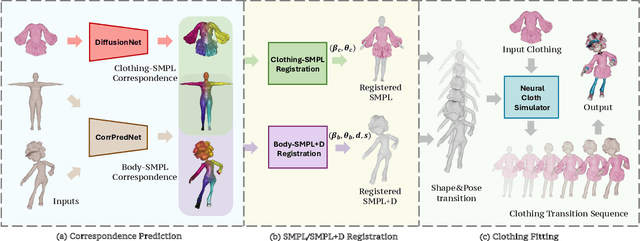

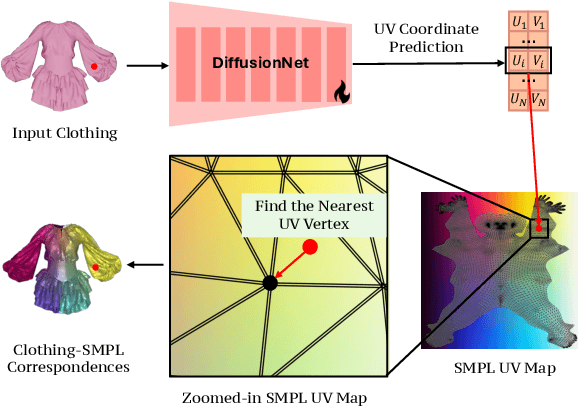
Abstract:We present LUIVITON, an end-to-end system for fully automated virtual try-on, capable of draping complex, multi-layer clothing onto diverse and arbitrarily posed humanoid characters. To address the challenge of aligning complex garments with arbitrary and highly diverse body shapes, we use SMPL as a proxy representation and separate the clothing-to-body draping problem into two correspondence tasks: 1) clothing-to-SMPL and 2) body-to-SMPL correspondence, where each has its unique challenges. While we address the clothing-to-SMPL fitting problem using a geometric learning-based approach for partial-to-complete shape correspondence prediction, we introduce a diffusion model-based approach for body-to-SMPL correspondence using multi-view consistent appearance features and a pre-trained 2D foundation model. Our method can handle complex geometries, non-manifold meshes, and generalizes effectively to a wide range of humanoid characters -- including humans, robots, cartoon subjects, creatures, and aliens, while maintaining computational efficiency for practical adoption. In addition to offering a fully automatic fitting solution, LUIVITON supports fast customization of clothing size, allowing users to adjust clothing sizes and material properties after they have been draped. We show that our system can produce high-quality 3D clothing fittings without any human labor, even when 2D clothing sewing patterns are not available.
Emotion Transfer with Enhanced Prototype for Unseen Emotion Recognition in Conversation
Aug 27, 2025Abstract:Current Emotion Recognition in Conversation (ERC) research follows a closed-domain assumption. However, there is no clear consensus on emotion classification in psychology, which presents a challenge for models when it comes to recognizing previously unseen emotions in real-world applications. To bridge this gap, we introduce the Unseen Emotion Recognition in Conversation (UERC) task for the first time and propose ProEmoTrans, a solid prototype-based emotion transfer framework. This prototype-based approach shows promise but still faces key challenges: First, implicit expressions complicate emotion definition, which we address by proposing an LLM-enhanced description approach. Second, utterance encoding in long conversations is difficult, which we tackle with a proposed parameter-free mechanism for efficient encoding and overfitting prevention. Finally, the Markovian flow nature of emotions is hard to transfer, which we address with an improved Attention Viterbi Decoding (AVD) method to transfer seen emotion transitions to unseen emotions. Extensive experiments on three datasets show that our method serves as a strong baseline for preliminary exploration in this new area.
Dialogues Aspect-based Sentiment Quadruple Extraction via Structural Entropy Minimization Partitioning
Aug 07, 2025Abstract:Dialogues Aspect-based Sentiment Quadruple Extraction (DiaASQ) aims to extract all target-aspect-opinion-sentiment quadruples from a given multi-round, multi-participant dialogue. Existing methods typically learn word relations across entire dialogues, assuming a uniform distribution of sentiment elements. However, we find that dialogues often contain multiple semantically independent sub-dialogues without clear dependencies between them. Therefore, learning word relationships across the entire dialogue inevitably introduces additional noise into the extraction process. To address this, our method focuses on partitioning dialogues into semantically independent sub-dialogues. Achieving completeness while minimizing these sub-dialogues presents a significant challenge. Simply partitioning based on reply relationships is ineffective. Instead, we propose utilizing a structural entropy minimization algorithm to partition the dialogues. This approach aims to preserve relevant utterances while distinguishing irrelevant ones as much as possible. Furthermore, we introduce a two-step framework for quadruple extraction: first extracting individual sentiment elements at the utterance level, then matching quadruples at the sub-dialogue level. Extensive experiments demonstrate that our approach achieves state-of-the-art performance in DiaASQ with much lower computational costs.
T-T: Table Transformer for Tagging-based Aspect Sentiment Triplet Extraction
May 08, 2025Abstract:Aspect sentiment triplet extraction (ASTE) aims to extract triplets composed of aspect terms, opinion terms, and sentiment polarities from given sentences. The table tagging method is a popular approach to addressing this task, which encodes a sentence into a 2-dimensional table, allowing for the tagging of relations between any two words. Previous efforts have focused on designing various downstream relation learning modules to better capture interactions between tokens in the table, revealing that a stronger capability to capture relations can lead to greater improvements in the model. Motivated by this, we attempt to directly utilize transformer layers as downstream relation learning modules. Due to the powerful semantic modeling capability of transformers, it is foreseeable that this will lead to excellent improvement. However, owing to the quadratic relation between the length of the table and the length of the input sentence sequence, using transformers directly faces two challenges: overly long table sequences and unfair local attention interaction. To address these challenges, we propose a novel Table-Transformer (T-T) for the tagging-based ASTE method. Specifically, we introduce a stripe attention mechanism with a loop-shift strategy to tackle these challenges. The former modifies the global attention mechanism to only attend to a 2-dimensional local attention window, while the latter facilitates interaction between different attention windows. Extensive and comprehensive experiments demonstrate that the T-T, as a downstream relation learning module, achieves state-of-the-art performance with lower computational costs.
Single View Garment Reconstruction Using Diffusion Mapping Via Pattern Coordinates
Apr 11, 2025Abstract:Reconstructing 3D clothed humans from images is fundamental to applications like virtual try-on, avatar creation, and mixed reality. While recent advances have enhanced human body recovery, accurate reconstruction of garment geometry -- especially for loose-fitting clothing -- remains an open challenge. We present a novel method for high-fidelity 3D garment reconstruction from single images that bridges 2D and 3D representations. Our approach combines Implicit Sewing Patterns (ISP) with a generative diffusion model to learn rich garment shape priors in a 2D UV space. A key innovation is our mapping model that establishes correspondences between 2D image pixels, UV pattern coordinates, and 3D geometry, enabling joint optimization of both 3D garment meshes and the corresponding 2D patterns by aligning learned priors with image observations. Despite training exclusively on synthetically simulated cloth data, our method generalizes effectively to real-world images, outperforming existing approaches on both tight- and loose-fitting garments. The reconstructed garments maintain physical plausibility while capturing fine geometric details, enabling downstream applications including garment retargeting and texture manipulation.
Multi-View Incongruity Learning for Multimodal Sarcasm Detection
Dec 01, 2024Abstract:Multimodal sarcasm detection (MSD) is essential for various downstream tasks. Existing MSD methods tend to rely on spurious correlations. These methods often mistakenly prioritize non-essential features yet still make correct predictions, demonstrating poor generalizability beyond training environments. Regarding this phenomenon, this paper undertakes several initiatives. Firstly, we identify two primary causes that lead to the reliance of spurious correlations. Secondly, we address these challenges by proposing a novel method that integrate Multimodal Incongruities via Contrastive Learning (MICL) for multimodal sarcasm detection. Specifically, we first leverage incongruity to drive multi-view learning from three views: token-patch, entity-object, and sentiment. Then, we introduce extensive data augmentation to mitigate the biased learning of the textual modality. Additionally, we construct a test set, SPMSD, which consists potential spurious correlations to evaluate the the model's generalizability. Experimental results demonstrate the superiority of MICL on benchmark datasets, along with the analyses showcasing MICL's advancement in mitigating the effect of spurious correlation.
Can Multimodal Large Language Model Think Analogically?
Nov 02, 2024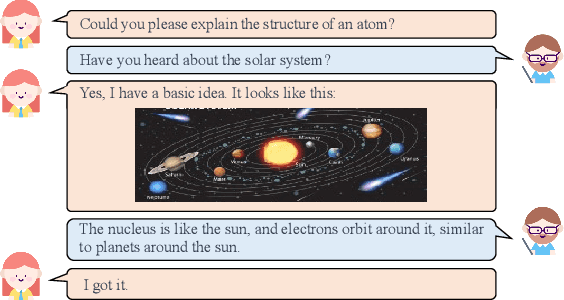
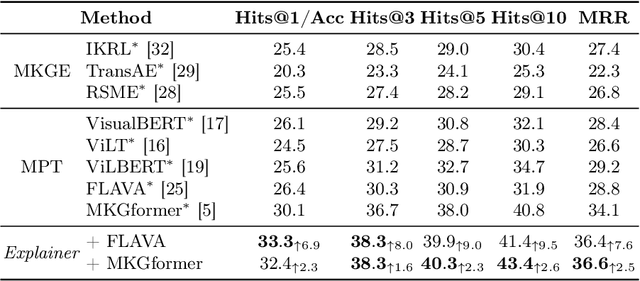
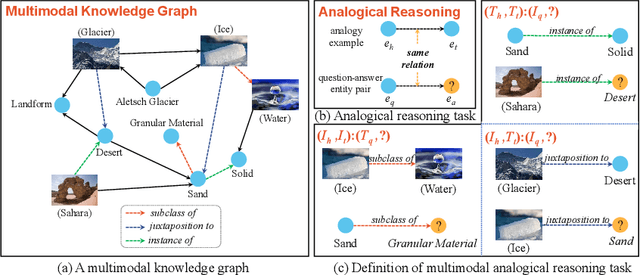
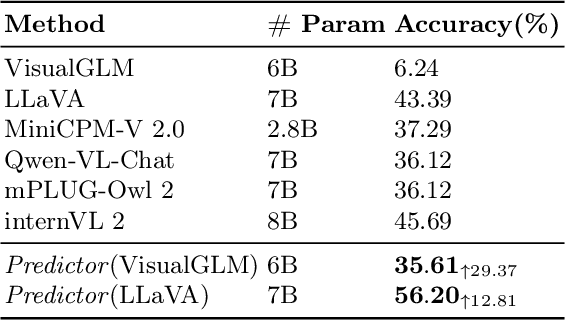
Abstract:Analogical reasoning, particularly in multimodal contexts, is the foundation of human perception and creativity. Multimodal Large Language Model (MLLM) has recently sparked considerable discussion due to its emergent capabilities. In this paper, we delve into the multimodal analogical reasoning capability of MLLM. Specifically, we explore two facets: \textit{MLLM as an explainer} and \textit{MLLM as a predictor}. In \textit{MLLM as an explainer}, we primarily focus on whether MLLM can deeply comprehend multimodal analogical reasoning problems. We propose a unified prompt template and a method for harnessing the comprehension capabilities of MLLM to augment existing models. In \textit{MLLM as a predictor}, we aim to determine whether MLLM can directly solve multimodal analogical reasoning problems. The experiments show that our approach outperforms existing methods on popular datasets, providing preliminary evidence for the analogical reasoning capability of MLLM.
Zero-shot Video Restoration and Enhancement Using Pre-Trained Image Diffusion Model
Jul 02, 2024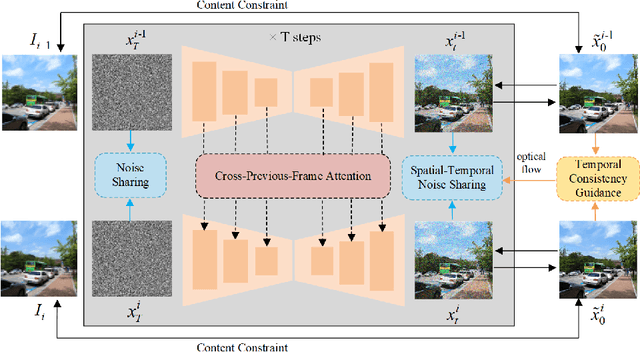


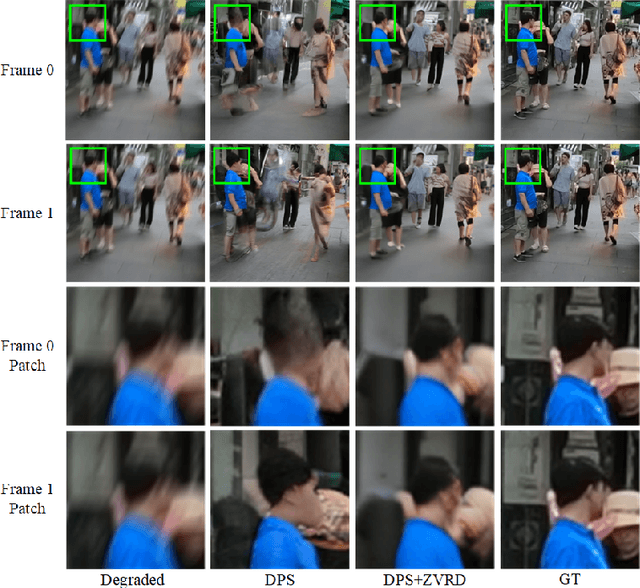
Abstract:Diffusion-based zero-shot image restoration and enhancement models have achieved great success in various image restoration and enhancement tasks without training. However, directly applying them to video restoration and enhancement results in severe temporal flickering artifacts. In this paper, we propose the first framework for zero-shot video restoration and enhancement based on a pre-trained image diffusion model. By replacing the self-attention layer with the proposed cross-previous-frame attention layer, the pre-trained image diffusion model can take advantage of the temporal correlation between neighboring frames. We further propose temporal consistency guidance, spatial-temporal noise sharing, and an early stopping sampling strategy for better temporally consistent sampling. Our method is a plug-and-play module that can be inserted into any diffusion-based zero-shot image restoration or enhancement methods to further improve their performance. Experimental results demonstrate the superiority of our proposed method in producing temporally consistent videos with better fidelity.
Physics-based deep learning reveals rising heating demand heightens air pollution in Norwegian cities
May 07, 2024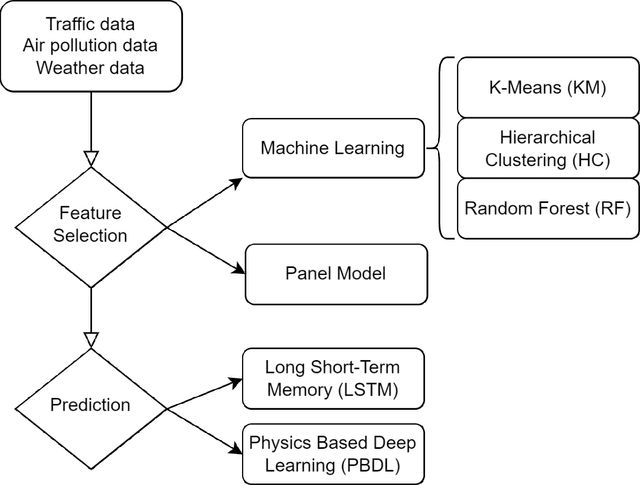
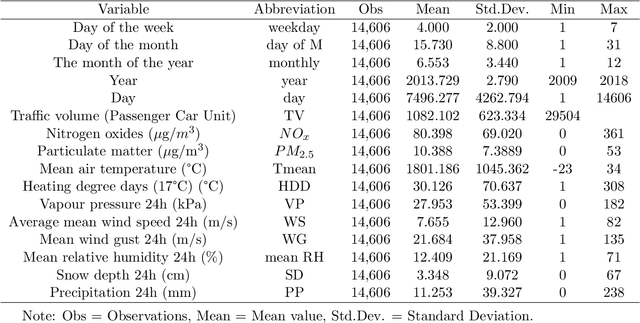
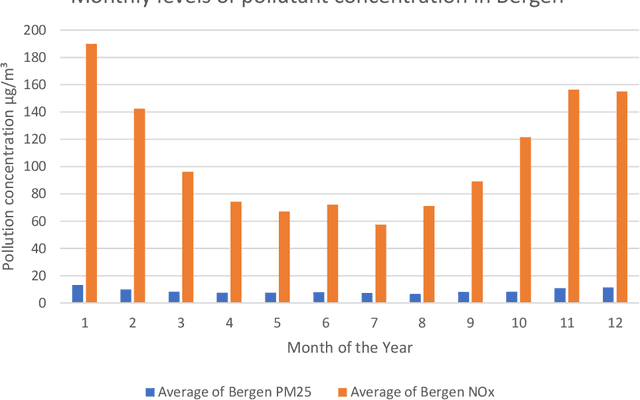
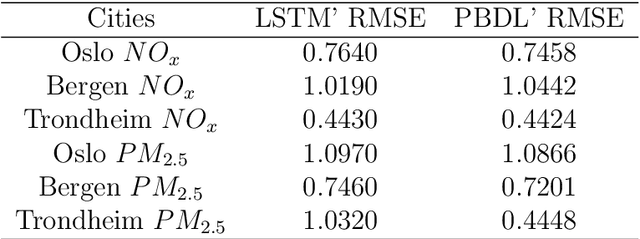
Abstract:Policymakers frequently analyze air quality and climate change in isolation, disregarding their interactions. This study explores the influence of specific climate factors on air quality by contrasting a regression model with K-Means Clustering, Hierarchical Clustering, and Random Forest techniques. We employ Physics-based Deep Learning (PBDL) and Long Short-Term Memory (LSTM) to examine the air pollution predictions. Our analysis utilizes ten years (2009-2018) of daily traffic, weather, and air pollution data from three major cities in Norway. Findings from feature selection reveal a correlation between rising heating degree days and heightened air pollution levels, suggesting increased heating activities in Norway are a contributing factor to worsening air quality. PBDL demonstrates superior accuracy in air pollution predictions compared to LSTM. This paper contributes to the growing literature on PBDL methods for more accurate air pollution predictions using environmental variables, aiding policymakers in formulating effective data-driven climate policies.
Landslide Surface Displacement Prediction Based on VSXC-LSTM Algorithm
Jul 24, 2023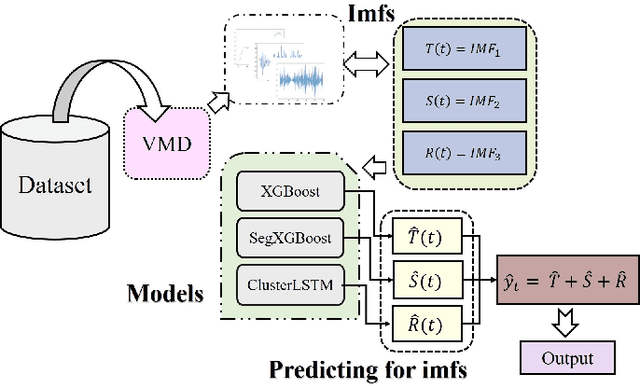
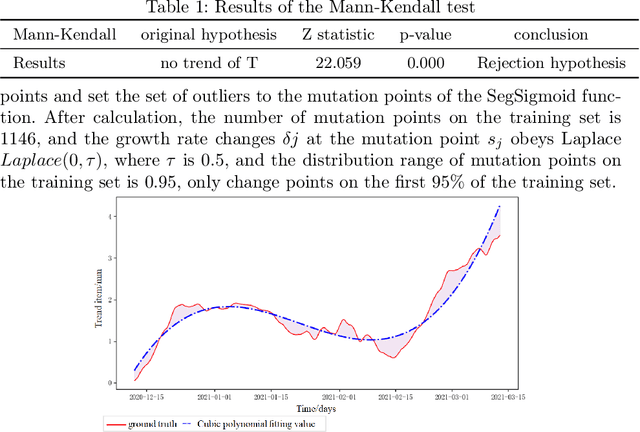
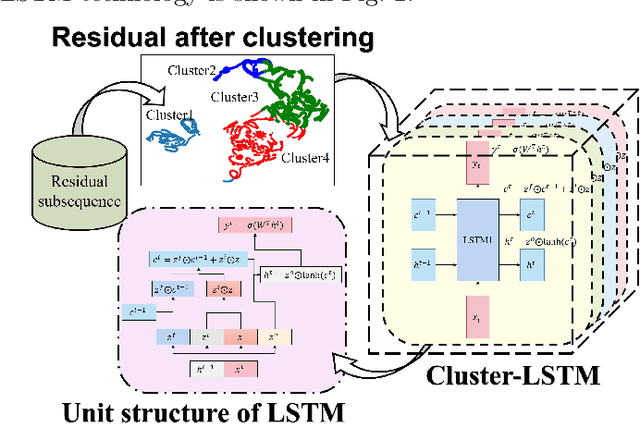

Abstract:Landslide is a natural disaster that can easily threaten local ecology, people's lives and property. In this paper, we conduct modelling research on real unidirectional surface displacement data of recent landslides in the research area and propose a time series prediction framework named VMD-SegSigmoid-XGBoost-ClusterLSTM (VSXC-LSTM) based on variational mode decomposition, which can predict the landslide surface displacement more accurately. The model performs well on the test set. Except for the random item subsequence that is hard to fit, the root mean square error (RMSE) and the mean absolute percentage error (MAPE) of the trend item subsequence and the periodic item subsequence are both less than 0.1, and the RMSE is as low as 0.006 for the periodic item prediction module based on XGBoost\footnote{Accepted in ICANN2023}.
 Add to Chrome
Add to Chrome Add to Firefox
Add to Firefox Add to Edge
Add to Edge